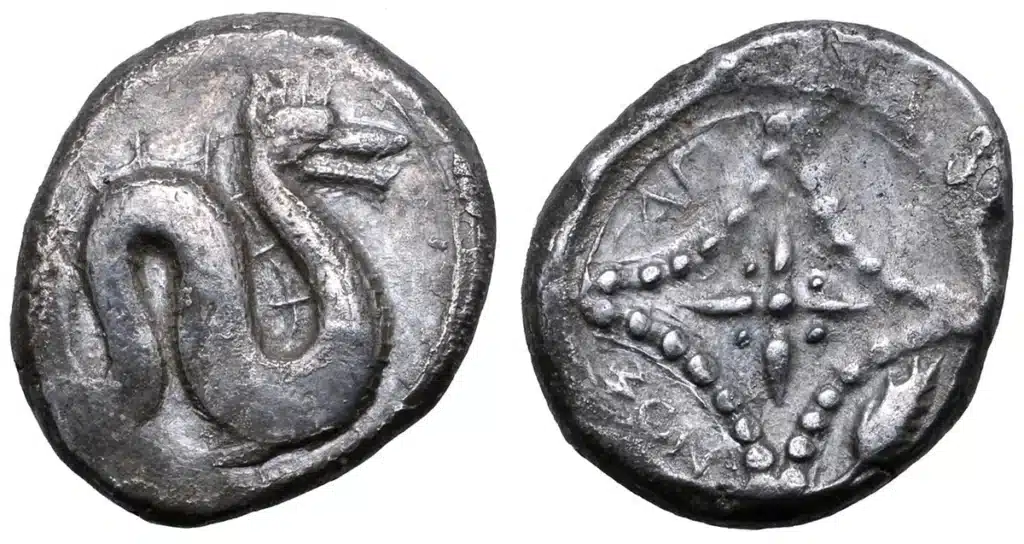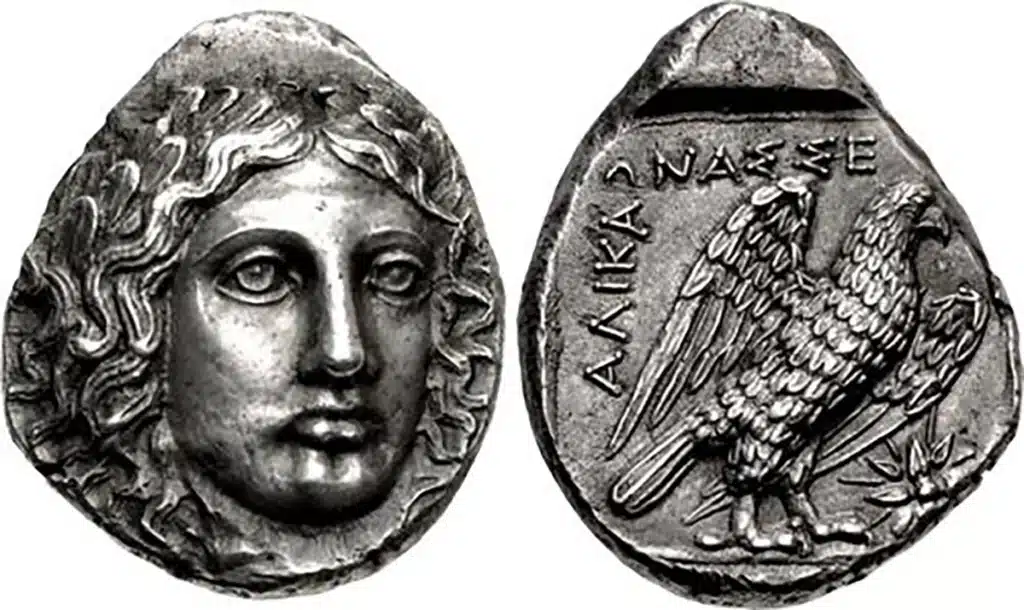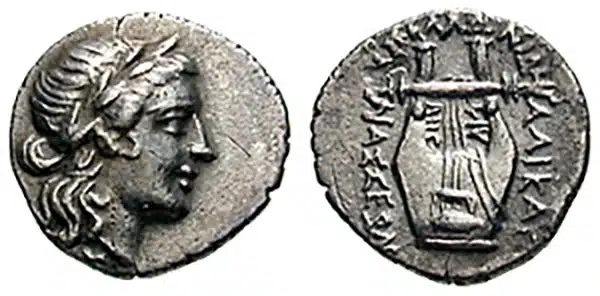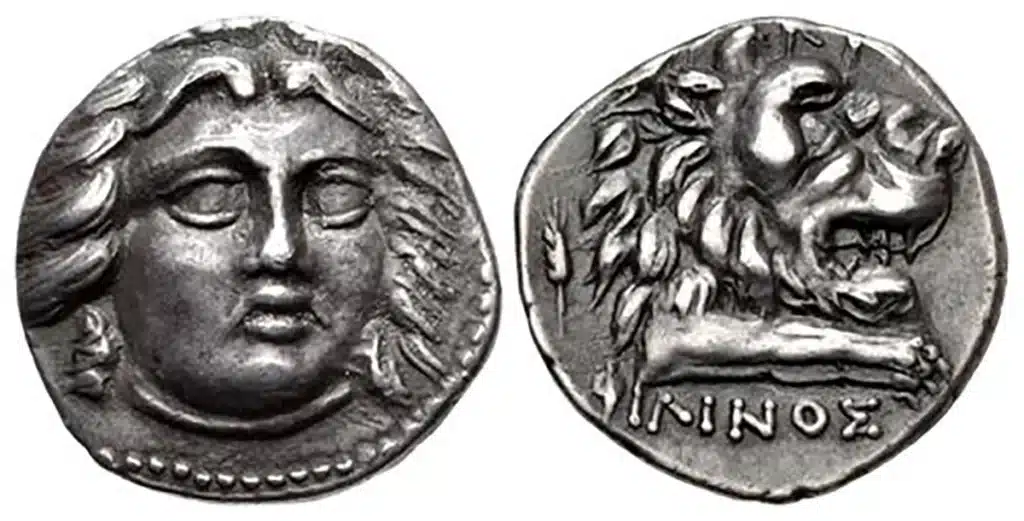
By Dr. Steve Benner for CoinWeek …..
This is the second article (Part I here) in a two-part series on the six cities of the Hexapolis located in Doris, a small region on the southwest coast of Asia Minor (see Figure 1) that later became part of Caria. The region was settled by the Dorians at the end of the Bronze Age (3300-1200 BCE) and was probably part of the Sea Peoples’ invasions of Greece and the Middle East. Ancient Greeks, such as the Spartans, believed this area was the home of the original Dorian invaders of the Peloponnese that proliferated the Doric dialect.
Established after 1100 BCE (all dates are BCE unless otherwise noted), the Dorian Hexapolis was a federation of six cites: Kos on the island of the same name; Knidos on the Triopian promontory (Datca peninsula); Halikarnassos on the mainland; and Lindos, Ialysos, and Kamiros on the island of Rhodes. This article covers Knidos and Halikarnassos since the first part covered those of Rhodes and Kos, a large and wealthy city with a rich history, would require an article unto itself.
The Hexapolis became prosperous around 700, and the cities were known for their seamanship. They would celebrate a festival with games near Knidos in honor of the Triopian Apollo. The prize of the games was a brass tripod that was to be dedicated to the Temple of Apollo. Halikarnassos was later expelled from the federation after a certain Agasicles improperly handled the tripod after winning it, thus turning the hexapolis into a pentapolis. The federation was dissolved around 560.

Coins of Halikarnassos
Halikarnassos was established on the site of a Mycenean (1700-1100) settlement and over 40 Mycenean beehive tombs (tholoi) are located near the city. It was founded by Dorians (probably from Troezen and Argos) around 900 on the Gulf of Kerme (see Figure 1). Anthes, a son of Poseidon, was considered its founder. When Cyrus the Great conquered Caria in 545, the city did not resist, and Cyrus placed a satrap in charge of the city. Unlike its Ionian neighbors, Halikarnassos did not rise against Persia during the Ionian Revolt (499-493) and thus did not suffer the consequences. In 520, the city’s satrap was Lygdamis, who established the Lygdamid dynasty. Lygdamis’ daughter was Artemisia I, who was put in charge of some of Xerxes’ forces during his losing effort to conquer Greece in 480.
After Lygdamis II, Artemisia’s grandson, died in 450, Halikarnassos joined the Delian League and remained a member until the end of the Peloponnesian War (404), when the League was disbanded. In 395, the city returned to Persian rule, and a new satrap named Hecatomnos was appointed to rule. When Hecatomnus died, he was succeeded by Mausolus (reigned 377-353) with his sister/wife Artemisia II. Upon his death, Artemisia commissioned the building of the Mausoleum (her husband’s name was the origin of the word) as a tomb for her husband. Completed only by 350, after both Mausolus’ and Artemisia’s deaths, this beautiful building became one of the “Seven Wonders of the Ancient World”.
On his way to conquer Persia, Alexander the Great arrived at the city in 334 and laid siege. It was taken with some difficulty and was extensively burned, never regaining its former glory. Halikarnassos was fought over by Alexander’s successors, except for a short period when it came under Rhodian rule in the second century BCE. After the death of the Egyptian queen Cleopatra VII in 30, the city was incorporated into the Roman Republic. The “Father of History”, Herodotus, was born in Halikarnassos (484) during Lygdamid rule but had to flee the city in 454, due to his connection with an uprising. The city had a theater (that is being restored), an agora, temples to Hermes and Ares, and city walls. Also nearby was a sanctuary of Apollo.
One of my sources says that Halikarnassos began to mint electrum staters and fractions around 600, but I could not find any corroboration in other sources. Therefore, ignoring the electrum coins, Halikarnassos began minting silver coins around the end of the fifth century. It appears that the first coins had either the head of Ketos (a sea monster) or its entire body with scales, forked tail, and sail on the obverse with both having a geometric pattern on the reverse. The former are hektes (2.09 grams) struck to the Milesian standard, and the latter are half staters struck to the Aeginetic standard (Figure 2). These coins are crudely done and don’t seem up to the standard of a major Greek city. Their minting was discontinued around 480.

At about the same time, small silver fractions were struck, some with the forepart of the winged horse Pegasos on the obverse and the forepart of a goat on the reverse (Figure 3). The city ethnic of ALI is on the reverse. The early versions of this coin type were as crude as the Ketos type, though they quickly improved in quality and artistry. Other small fractions had a ram’s head obverse and either Apollo’s head, a young female’s head, or a lion’s head reverse. These continued to be minted well into the fourth century.

There was no change to the coinage until the beginning of the fourth century when Halikarnassos began minting very attractive tetradrachms, drachms, and hemidrachms with Apollo facing slightly right on the obverse and an eagle spreading its wings in an incuse square on the reverse (Figure 4). The city’s/people’s name of AΛIKAPNAΣΣEΩN is shown around the eagle. This coin is probably based on civic and Rhodian coinage and is in marked contrast to earlier coins, which were not artistically appealing. The city must have hired gifted celators (artisans who engraved coin dies) or had them minted elsewhere. The city’s first bronze coins started to be minted at this time.

In the fourth century, the satraps of Caria, including Mausolos, Hidrieus, Pixodaros, and Orontobates, began minting tetradrachms and didrachms similar to the type shown in Figure 4. The difference is that these coins had Zeus Labraundos standing right holding a staff on the reverse instead of the eagle (Figure 5). The name of the satrap is also on the reverse. They are of the same high quality as the previous coin. The didrachms are fairly common, but the tetradrachms are rare, with only a handful known. In addition to the silver coins, the satraps also minted gold staters. Two of the known examples are a hemistater (4.25 grams) with Apollo’s head facing right and the same reverse as Figure 5 and a 1/24 stater (0.34 grams) with Apollo facing left obverse and a labrys (double-bladed axe) reverse.

Alexander’s siege ended the dynasts of Caria, and the city retained the right to mint bronze coins. There was a large variety of types, some of which were based on the silver coin types. Very few coins were struck until the second century when Halikarnassos came under Rhodian control (c. 188-166). Then the city produced silver drachms of 4.21 grams, as well as some fractions like the hemidrachm and trihemiobol. Examples of the types were Helios facing forward/bust of Athena; the head of Apollo/lyre; and the bust of Athena/owl. Figure 6 shows an example of the hemidrachm.
The silver coins and bronze coins continued to be produced until the middle of the first century.

Coins of Knidos
Knidos was located on the coast of Caria opposite the islands of Nisyros and Telos. It was built partially on the island of Triopion and connected to the mainland by a causeway, which formed two harbors, one military and one commercial. The island was settled by Spartans in the first millennium and later by Argives (people from Argos), and the city was built on a series of terraces rising to an acropolis. The Temple of Apollo near Knidos was the site of the Dorian Games. Also, temples to Poseidon, Artemis Hyakinthotropos (the patron goddess), and Aphrodite Euploia were located there. The later deity was likely inherited from the Phoenicians and was much older than the others, with the goddess appearing on most of the city’s coinage.
Knidos also had a council chamber, a stadium, a theater, and a portico. It produced wine, onions, medicinal oils, and reeds for pens, and accumulated enough wealth to colonize the island of Lipara (north of Sicily) and the city of Kokyra Nigra (in the Adriatic Sea). It submitted to Persia after 546, joined the Delian League after 479, and revolted against the League in 412. The city’s oligarchy was replaced by a democracy in the fourth century, but after Alexander the Great’s death Knidos came under Ptolemaic control. It was under Ptolemaic rule that the architect Sostratus of Knidos designed and completed the Lighthouse at Alexandria. The city came under Rhodian control in the early second century, and then under Roman control around 129.
Most of the coinage of Knidos has the head of a roaring lion on the obverse and the head of Aphrodite on the reverse (see Figure 7). The minting of drachms of about six grams (Aeginetic standard) began about 520 BCE, with the head of Aphrodite appearing archaic. Later into the fifth century, the head became more classical, and the city ethnic K-N-I was added to the reverse. The silver fractions, such as diobols, obols, etc., were first minted in the fourth century and used the same classical style.

Around 400, Knidos adopted the Rhodian standard of 3.9 grams per drachm. Between 394 and 390, Knidos was a member of a Federation with the cities of Iasos, Rhodes, Samos, Ephesos, and Byzantion and minted tridrachms of 10.9 grams to match the group. Figure 8 shows Knidos’ federal coinage, which has an obverse of baby Herakles killing two snakes and a reverse of Aphrodite facing right. The obverse has the legend SUN (“Federation”) and the reverse has the city ethnic KNIDIWN.

In about 390, the city began minting very beautiful tetradrachms (15 grams), didrachms, drachms, and hemidrachms with Aphrodite on the obverse and the head of a lion on the reverse (see Figure 9). A magistrate’s name could appear on the reverse along with the ethnic KNI. This type was continued into the third century. A hemidrachm was also produced that had Aphrodite on the obverse and a bull’s head facing on the reverse. In the mid-third century, the tetrobols and hemidrachms were changed to have Artemis on the obverse and a tripod on the reverse (see Figure 10).


In the latter part of the third century, Knidos produced a series of tetradrachms that reproduced the Alexander the Great type, with the head of Herakles on the obverse and Zeus seated on the reverse. The coins had a prow and EY on the reverse. Under Rhodian rule (210-185), the city minted didrachms with the head of Rhodian Helios facing three-quarters on the obverse and a reverse with the forepart of a lion with either a rose, an ear of grain, a star, a cap, a club, or a bug, etc. The city name, KNIΔION, is above and a magistrate’s name is below the lion.
The silver coinage ended about the time the city came under Roman control in the latter third of the second century. Knidos also minted bronze coins starting in the third century, and these include many types, regrettably too many to cover here.

Comments
There are many coins in this article that are very rare, beautiful, and expensive, especially the multi-drachm coins (Figures 4, 5, 9, and 11) and some drachms (Figure 8). But for collectors of more modest means, most of the smaller silver fraction can be obtained at reasonable prices. The early Ketos silver coins of Halikarnassos are crude but intriguing because there aren’t many sea monsters on Greek coins (or any coins). I believe they warrant more careful study. Even though I did not cover them, there is a wide variety of inexpensive bronze coins from both these cities.
* * *
Reference
Classical Numismatic Group (CNG)
Grant, Michael. A Guide to the Ancient World: A Dictionary of Classical Place Names. Barnes and Noble (1986)
Head, Barclay V. Historia Numorum: A Manual of Greek Numismatics. Oxford (1887)
Hoover, Oliver. Handbook of Coins of the Islands, Vol 6. Lancaster/London: Classical Numismatic Group, Inc. (2010)
Hornblower, Simon, and Antony Spawforth, ed. The Oxford Classical Dictionary, 3rd edition. Oxford (1996)
Sear, David. Greek Coins and Their Values, Vol 2: Asia. B.A. Seaby Ltd. (1979)
* * *
The post Coinage of the Dorian Cities of Halikarnassos and Knidos appeared first on CoinWeek: Rare Coin, Currency, and Bullion News for Collectors.